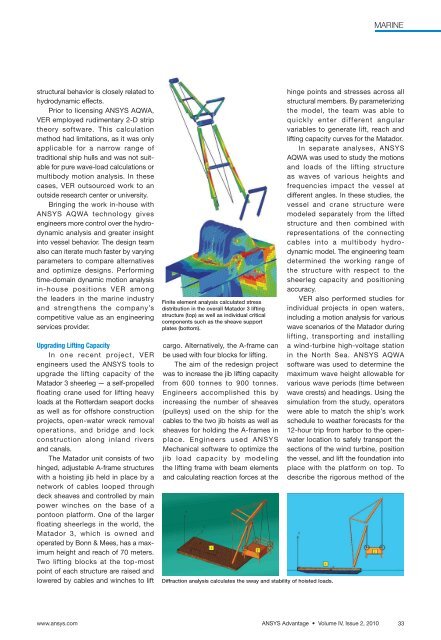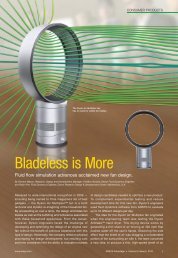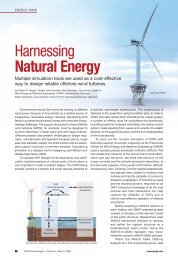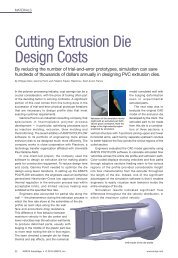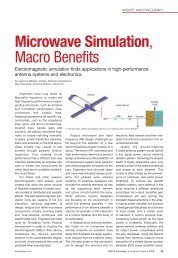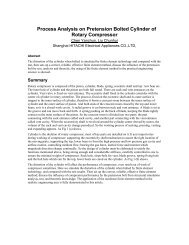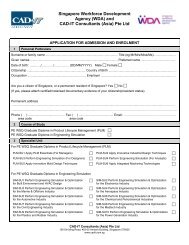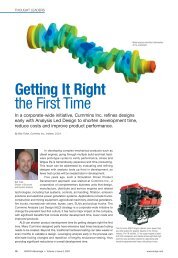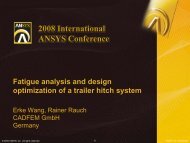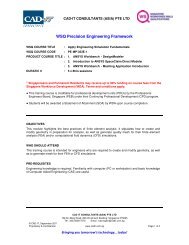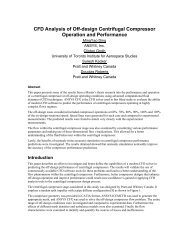Ship-Shape Simulation - Ansys
Ship-Shape Simulation - Ansys
Ship-Shape Simulation - Ansys
You also want an ePaper? Increase the reach of your titles
YUMPU automatically turns print PDFs into web optimized ePapers that Google loves.
marine<br />
structural behavior is closely related to<br />
hydrodynamic effects.<br />
Prior to licensing ANSYS AQWA,<br />
VER employed rudimentary 2-D strip<br />
theory software. This calculation<br />
method had limitations, as it was only<br />
applicable for a narrow range of<br />
traditional ship hulls and was not suitable<br />
for pure wave-load calculations or<br />
multibody motion analysis. In these<br />
cases, VER outsourced work to an<br />
outside research center or university.<br />
Bringing the work in-house with<br />
ANSYS AQWA technology gives<br />
engineers more control over the hydrodynamic<br />
analysis and greater insight<br />
into vessel behavior. The design team<br />
also can iterate much faster by varying<br />
parameters to compare alternatives<br />
and optimize designs. Performing<br />
time-domain dynamic motion analysis<br />
in-house positions VER among<br />
the leaders in the marine industry<br />
and strengthens the company’s<br />
competitive value as an engineering<br />
services provider.<br />
Upgrading Lifting Capacity<br />
In one recent project, VER<br />
engineers used the ANSYS tools to<br />
upgrade the lifting capacity of the<br />
Matador 3 sheerleg — a self-propelled<br />
floating crane used for lifting heavy<br />
loads at the Rotterdam seaport docks<br />
as well as for offshore construction<br />
projects, open-water wreck removal<br />
operations, and bridge and lock<br />
construction along inland rivers<br />
and canals.<br />
The Matador unit consists of two<br />
hinged, adjustable A-frame structures<br />
with a hoisting jib held in place by a<br />
network of cables looped through<br />
deck sheaves and controlled by main<br />
power winches on the base of a<br />
pontoon platform. One of the larger<br />
floating sheerlegs in the world, the<br />
Matador 3, which is owned and<br />
operated by Bonn & Mees, has a maximum<br />
height and reach of 70 meters.<br />
Two lifting blocks at the top-most<br />
point of each structure are raised and<br />
lowered by cables and winches to lift<br />
Finite element analysis calculated stress<br />
distribution in the overall Matador 3 lifting<br />
structure (top) as well as individual critical<br />
components such as the sheave support<br />
plates (bottom).<br />
cargo. Alternatively, the A-frame can<br />
be used with four blocks for lifting.<br />
The aim of the redesign project<br />
was to increase the jib lifting capacity<br />
from 600 tonnes to 900 tonnes.<br />
Engineers accomplished this by<br />
increasing the number of sheaves<br />
(pulleys) used on the ship for the<br />
cables to the two jib hoists as well as<br />
sheaves for holding the A-frames in<br />
place. Engineers used ANSYS<br />
Mechanical software to optimize the<br />
jib load capacity by modeling<br />
the lifting frame with beam elements<br />
and calculating reaction forces at the<br />
Diffraction analysis calculates the sway and stability of hoisted loads.<br />
hinge points and stresses across all<br />
structural members. By parameterizing<br />
the model, the team was able to<br />
quickly enter different angular<br />
variables to generate lift, reach and<br />
lifting capacity curves for the Matador.<br />
In separate analyses, ANSYS<br />
AQWA was used to study the motions<br />
and loads of the lifting structure<br />
as waves of various heights and<br />
frequencies impact the vessel at<br />
different angles. In these studies, the<br />
vessel and crane structure were<br />
modeled separately from the lifted<br />
structure and then combined with<br />
representations of the connecting<br />
cables into a multibody hydrodynamic<br />
model. The engineering team<br />
determined the working range of<br />
the structure with respect to the<br />
sheerleg capacity and positioning<br />
accuracy.<br />
VER also performed studies for<br />
individual projects in open waters,<br />
including a motion analysis for various<br />
wave scenarios of the Matador during<br />
lifting, transporting and installing<br />
a wind-turbine high-voltage station<br />
in the North Sea. ANSYS AQWA<br />
software was used to determine the<br />
maximum wave height allowable for<br />
various wave periods (time between<br />
wave crests) and headings. using the<br />
simulation from the study, operators<br />
were able to match the ship’s work<br />
schedule to weather forecasts for the<br />
12-hour trip from harbor to the openwater<br />
location to safely transport the<br />
sections of the wind turbine, position<br />
the vessel, and lift the foundation into<br />
place with the platform on top. To<br />
describe the rigorous method of the<br />
www.ansys.com ANSYS Advantage • Volume IV, Issue 2, 2010 33


